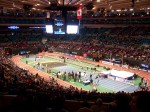Track and field is one of the longest-running sports on the collegiate calendar, spanning from the middle of January to early June.
The sport is broken up into two distinct seasons, however. And each comes with a particular set of features that athletes have to adapt to.
The first of the two seasons, which starts in January and concludes with the NCAA Indoor Championships in early March, is indoors.
The indoor season presents a unique set of challenges for both runners and throwers.
The first and most noticeable is the banking on the curved parts of some indoor tracks. The Armory’s New Balance Track & Field Center in New York – where the Bruins competed earlier this season – has a banked track.
The turns on shorter tracks mean that, at speed, athletes will have to fight more inertia as they run along the turn. The banking helps athletes cope with these centrifugal forces so that they can maintain their speed.
“At first, it can be intimidating,” said senior sprinter Leon Powell. “You have to get used to running on the curves. Learning how to accelerate down and catch your feet and keep your feet under you … it is definitely a huge difference.”
Tracks can be banked at up to 10 degrees, depending on the severity of the curve. The shorter the curve, the steeper the banking.
That and the shorter distance – indoor tracks are 200 meters long for a full lap, half the distance of an outdoor oval – has had a noticeable effect on athletes who have run for the Bruins over the years.
UCLA’s record in the indoor 200-meter currently stands at 20.99 seconds. By comparison, every single 200-meter on the outdoor all-time top-10 list is faster.
But the differences are not limited to the track events – there are several differences for the field events as well. Most notable is the exclusion of the javelin throw altogether.
In addition to that, throws coach John Frazier said the training his athletes undergo for indoor season can be very different, especially if they are looking ahead to the outdoor season.
“The biggest difference is going from the weight (throw) to the hammer,” Frazier said. “I try to coach the weight throw like the hammer so we’re prepared for outdoor.”
Because the hammer throw and weight throw are different, Frazier will soon begin to taper off training for the weight throw despite having a few weeks left in the indoor season. He’ll do this to ensure that his throwers are prepared for the change, and to get them used to a slightly different training regimen.
Perhaps the biggest discrepancy between the indoor and outdoor seasons that affects every athlete is the weather.
During the indoor games, sprinters do not face headwinds or tailwinds, and jumpers don’t have to deal with rain. Additionally, thunderstorms have in the past forced meets to end early, changing the potential finishing order of some events.
At the 2016 NCAA Western Regionals, thunderstorms and lightning pushed the sprinting events back, and a decision was made to put the top-three sprinters from each preliminary heat through to nationals.
Sprinters in the 400-meter hurdles had to run just one race instead of two in order to qualify for the NCAA championship.
The differences between indoor and outdoor track and field are experienced abruptly, too. With the end of the indoor meets around the corner, the Bruins and athletes across the nation will soon have to contend the changes the outdoor season demands of them.
